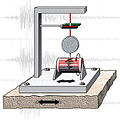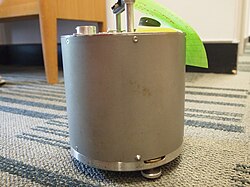Seismometer
A seismometer or seismograph is an instrument that measures motions of the ground, including those generated by earthquakes, nuclear explosions and other sources.
Records of seismic waves called seismograms allow us to map the interior of the Earth, and to find and measure the size of those different sources.[1]
The word derives from the Greek word, seismós, a shaking or quake, from the verb σείω, seíō, to shake; and μέτρον, métron, measure.
The technique of using a seismometer to build up a picture of the Earth's interior is called seismic tomography.[2]
Seismometer Media
Replica of Zhang Heng's seismoscope Houfeng Didong Yi
Milne horizontal pendulum seismometer. One of the Important Cultural Properties of Japan. Exhibit in the National Museum of Nature and Science, Tokyo, Japan.
Seismometer in operation recording a seismogram.
References
- ↑ Richter, C.F. (1958). Elementary Seismology. San Francisco: W.H. Freeman.
- ↑ Nolet, Guust (ed) 1987. Seismic tomography: seismology and exploration geophysics. Springer Netherlands. ISBN 9789027725837
Other websites
| Wikimedia Commons has media related to Lua error in Module:Commons_link at line 62: attempt to index field 'wikibase' (a nil value).. |
- The history of early seismometers Archived 2003-04-15 at the Wayback Machine
- A Java code applet demonstrating the operation of a damped-mass seismometer
- Keeping track Archived 2009-02-01 at the Wayback Machine






